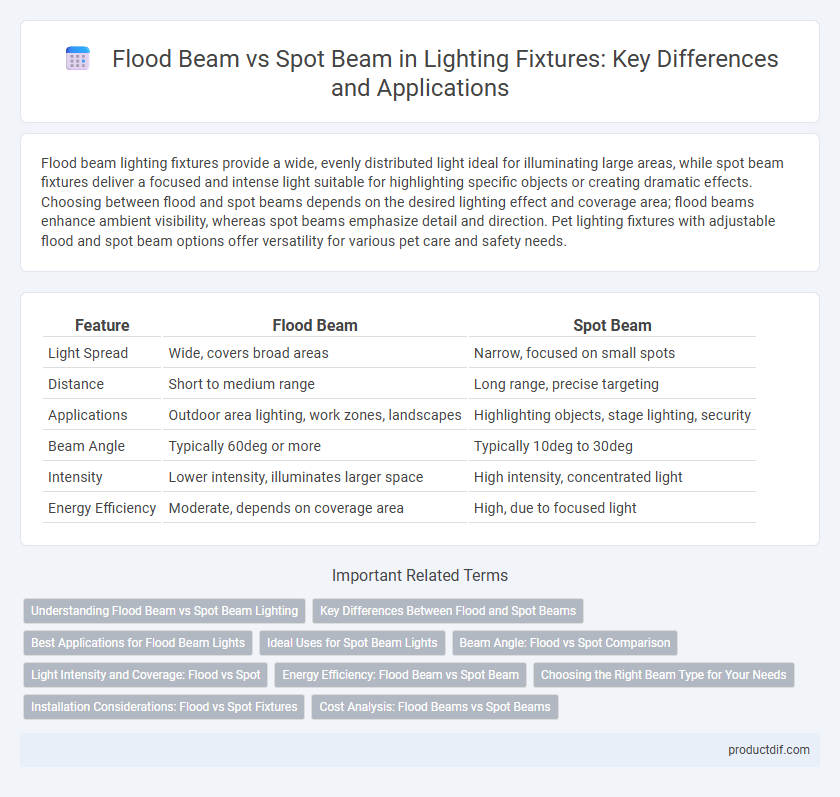Flood beam lighting fixtures provide a wide, evenly distributed light ideal for illuminating large areas, while spot beam fixtures deliver a focused and intense light suitable for highlighting specific objects or creating dramatic effects. Choosing between flood and spot beams depends on the desired lighting effect and coverage area; flood beams enhance ambient visibility, whereas spot beams emphasize detail and direction. Pet lighting fixtures with adjustable flood and spot beam options offer versatility for various pet care and safety needs.
Table of Comparison
| Feature | Flood Beam | Spot Beam |
|---|---|---|
| Light Spread | Wide, covers broad areas | Narrow, focused on small spots |
| Distance | Short to medium range | Long range, precise targeting |
| Applications | Outdoor area lighting, work zones, landscapes | Highlighting objects, stage lighting, security |
| Beam Angle | Typically 60deg or more | Typically 10deg to 30deg |
| Intensity | Lower intensity, illuminates larger space | High intensity, concentrated light |
| Energy Efficiency | Moderate, depends on coverage area | High, due to focused light |
Understanding Flood Beam vs Spot Beam Lighting
Flood beam lighting provides a wide, diffused illumination ideal for lighting large areas such as outdoor spaces or work sites, with beam angles typically ranging from 45 to 120 degrees. Spot beam lighting offers a narrow, concentrated light focused on a specific target, often featuring beam angles between 10 and 45 degrees, making it suitable for highlighting objects or creating dramatic effects. Understanding the difference between flood and spot beams is essential for selecting the appropriate lighting fixture based on the required coverage and intensity.
Key Differences Between Flood and Spot Beams
Flood beams emit wide, evenly distributed light covering large areas, ideal for general illumination in outdoor or work environments. Spot beams produce narrow, concentrated light with a focused reach, suitable for highlighting specific objects or distant targets. Key differences include beam angle, intensity, and coverage distance, influencing their applications in lighting fixtures.
Best Applications for Flood Beam Lights
Flood beam lights emit a wide, even spread of light ideal for illuminating large outdoor areas such as gardens, sports fields, and parking lots. Their broad coverage ensures enhanced safety and visibility in spaces requiring diffuse illumination rather than concentrated beams. Floodlights are especially effective for security lighting and general area lighting where diffuse brightness is prioritized over focused intensity.
Ideal Uses for Spot Beam Lights
Spot beam lights are ideal for highlighting specific objects or areas with focused, intense illumination, making them perfect for accentuating architectural features, artwork, or signage. Their narrow beam angle provides precise control over light placement, reducing light spill and enhancing visual impact in outdoor pathways, stage lighting, and display settings. Spot beams are also effective in security lighting where targeted brightness improves visibility without disturbing surrounding areas.
Beam Angle: Flood vs Spot Comparison
Flood beams typically have a wide beam angle ranging from 60 to 120 degrees, which allows for broad area illumination ideal for outdoor spaces and large rooms. Spot beams have a narrow beam angle, usually between 15 to 45 degrees, concentrating light on a specific area or object to create focused highlighting or accent lighting. Choosing between flood and spot beams depends on the desired light spread and application, with flood beams offering diffused coverage and spot beams providing precision and intensity.
Light Intensity and Coverage: Flood vs Spot
Flood beams emit a wide light pattern with moderate intensity, ideal for illuminating large areas like yards or workspaces, providing broad coverage and uniform brightness. Spot beams concentrate light into a narrow, high-intensity beam, enhancing visibility over long distances and making them suitable for tasks requiring focused illumination such as searchlights or stage lighting. Choosing between flood and spot beams depends on the need for extensive coverage versus intense, directed light.
Energy Efficiency: Flood Beam vs Spot Beam
Flood beams distribute light over a wide area, which can lead to higher energy consumption when illuminating large spaces, while spot beams concentrate light on a specific target, optimizing energy use by reducing wasted light. Spot beams typically offer better energy efficiency in applications requiring focused illumination, such as task lighting or highlighting objects. Flood beams are more suitable for broad-area lighting but may require higher wattage fixtures to maintain intensity, impacting overall energy consumption.
Choosing the Right Beam Type for Your Needs
Flood beams provide wide, even illumination ideal for lighting large outdoor areas, making them perfect for security and landscape lighting. Spot beams offer a narrow, focused light for highlighting specific objects or areas, ideal for accent lighting or task illumination. Selecting between flood and spot beams depends on whether you need broad coverage or targeted brightness for your lighting project.
Installation Considerations: Flood vs Spot Fixtures
Flood beam fixtures require wider spacing and higher mounting positions to ensure broad area coverage and minimize shadows, making them ideal for outdoor security or landscape lighting. Spot beam fixtures demand precise aiming and lower or adjustable mounting heights to concentrate light on specific objects or areas, commonly used in stage, architectural, or display lighting. Proper installation balances beam type, mounting height, fixture angle, and ambient conditions to achieve optimal illumination and energy efficiency.
Cost Analysis: Flood Beams vs Spot Beams
Flood beams generally incur lower upfront costs due to simpler lens and reflector designs compared to spot beams, which require more precise optics for concentrated light output. Maintenance expenses for spot beams can be higher as their focused light often demands higher wattage bulbs and more frequent replacements to maintain intensity. Energy efficiency also varies, with flood beams typically covering wider areas at lower power consumption, offering cost savings in large, open spaces.
Flood beam vs spot beam Infographic

 productdif.com
productdif.com